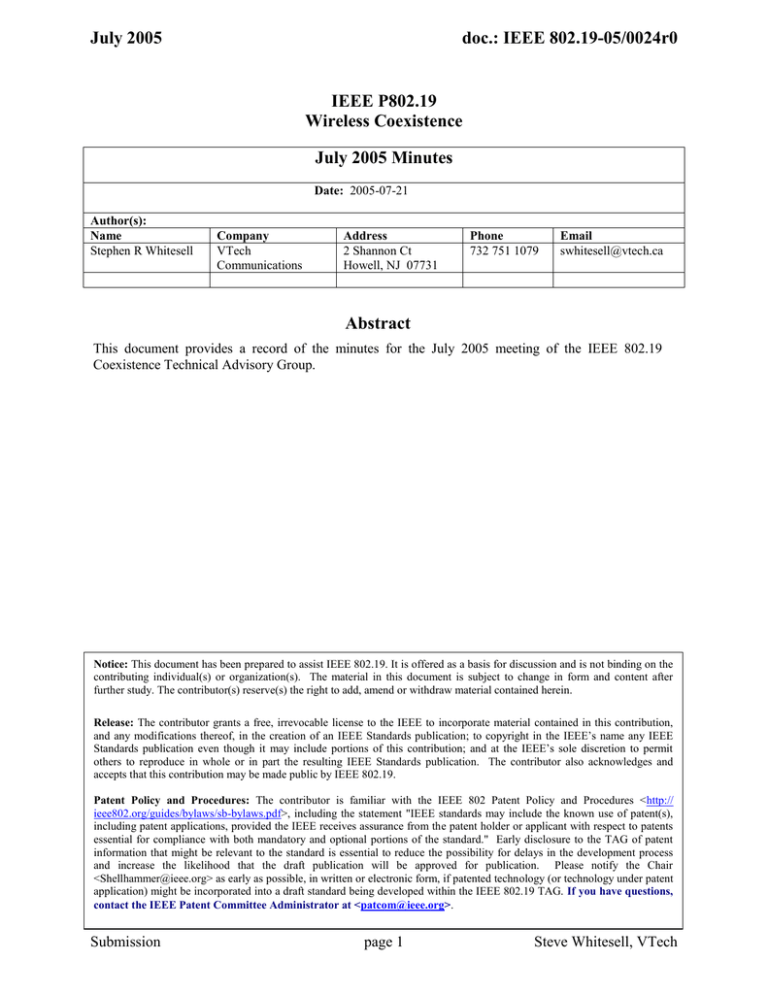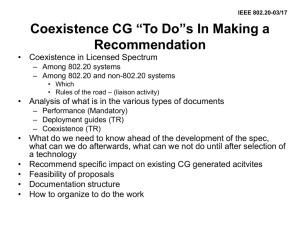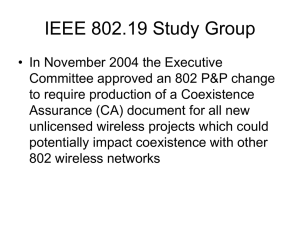July 2005 doc.: IEEE 802.19-05/0024r0 IEEE P802.19
advertisement

July 2005 doc.: IEEE 802.19-05/0024r0 IEEE P802.19 Wireless Coexistence July 2005 Minutes Date: 2005-07-21 Author(s): Name Stephen R Whitesell Company VTech Communications Address 2 Shannon Ct Howell, NJ 07731 Phone 732 751 1079 Email swhitesell@vtech.ca Abstract This document provides a record of the minutes for the July 2005 meeting of the IEEE 802.19 Coexistence Technical Advisory Group. Notice: This document has been prepared to assist IEEE 802.19. It is offered as a basis for discussion and is not binding on the contributing individual(s) or organization(s). The material in this document is subject to change in form and content after further study. The contributor(s) reserve(s) the right to add, amend or withdraw material contained herein. Release: The contributor grants a free, irrevocable license to the IEEE to incorporate material contained in this contribution, and any modifications thereof, in the creation of an IEEE Standards publication; to copyright in the IEEE’s name any IEEE Standards publication even though it may include portions of this contribution; and at the IEEE’s sole discretion to permit others to reproduce in whole or in part the resulting IEEE Standards publication. The contributor also acknowledges and accepts that this contribution may be made public by IEEE 802.19. Patent Policy and Procedures: The contributor is familiar with the IEEE 802 Patent Policy and Procedures <http:// ieee802.org/guides/bylaws/sb-bylaws.pdf>, including the statement "IEEE standards may include the known use of patent(s), including patent applications, provided the IEEE receives assurance from the patent holder or applicant with respect to patents essential for compliance with both mandatory and optional portions of the standard." Early disclosure to the TAG of patent information that might be relevant to the standard is essential to reduce the possibility for delays in the development process and increase the likelihood that the draft publication will be approved for publication. Please notify the Chair <Shellhammer@ieee.org> as early as possible, in written or electronic form, if patented technology (or technology under patent application) might be incorporated into a draft standard being developed within the IEEE 802.19 TAG. If you have questions, contact the IEEE Patent Committee Administrator at <patcom@ieee.org>. Submission page 1 Steve Whitesell, VTech July 2005 doc.: IEEE 802.19-05/0024r0 The IEEE 802.19 Coexistence Tag met in conjunction with the IEEE 802 Plenary meeting in San Francisco during the week of July 18-22, 2005. Minutes for each of the sessions held during the week are provided below. Tuesday AM Chair Steve Shellhammer called the meeting to order at 8:05 am on Tuesday, July 19, 2005. The Agenda was reviewed, slight modifications were made, and it was approved as 19-05-0019-04-0000 (05/0019r4). The chair then presented the opening report (05/0021r0), where he reviewed the objectives for the meeting and called the participants attention to the IEEE SA Patent Policy. Secretary Steve Whitesell did not attend the May meeting in Cairns, Australia. Minutes were taken but were not available for review. The first main topic of business was to review the draft 802.19 Policies and Procedures in 05/0010r7. This draft reflects changes made at the Cairns meeting to resolve ballot comments as described in 05/0016r1. Comments SRW17, SRW22, and SRW23 had been declined at the Cairns meeting. Steve Whitesell indicated he still felt there was an issue because the last step in the flow chart of the “Individual TAG member comment generation” process refers to “consolidating” the comments. He noted that a whole additional multi-step process called “Consolidation of TAG member comments” follows this step. He also noted that the text in clauses 6.2.2 and 6.2.3 have the same problem. After further discussion, the group agreed to retitle the follow-on process as “Determination of TAG position.” This change will be made in Figure 1 and the title of clause 6.2.3. The final revised version of the document is 05/0010r9. The next topic of discussion dealt with the Contention-Based Protocol (CBP) Study Group in 802.11. Chair Steve Shellhammer presented a summary (05/0022r0) on the background and the draft PAR and 5 Criteria created by this group. Although it was created as an 802.11 Study Group, participation is open to all Wireless working group and TAG members. The intent is to develop a standard to allow operation in the 3650-3700 MHz band recently opened by the FCC. Steve noted that, as he understood the plan, it would develop a contention-based protocol to allow 802.11 devices to coexist with each other under the rules the FCC is mandating. However, it did not envision the interworking of 802.11 devices with those of other 802 wireless standards. He then asked the following question: Should the 802.19 TAG encourage the CBP-SG to develop a spectrum sharing technique to enable sharing of all wireless standards intended to operate in that band? After discussion, it was agreed the Chair should raise this issue in the 802.11 mid-week plenary. Document 05/0023r2 captures the questions to be raised. However, it was noted that the Commission had received several petitions for reconsideration on the order opening up this band. Depending how the FCC responds, this project may not progress until after the next plenary. Another topic of discussion was whether to establish liaison with the group working on new IEEE Project P1900.2. This is a general project dealing with coexistence/interference between different types of radio systems operating in the same frequency band, or even in different bands. It was agreed that we should participate. Chair Steve Shellhammer will convey this message to P1900.2 Chair Steve Berger. Tom Siep presented 05/0018r0 on coexistence with 802.15.1a devices. The document covers the characteristics that need to be taken into account when doing coexistence analyses. The presentation was originally made to 802.11 TGN and the document has been updated to reflect comments received. Tom provided a general description of 802.15.1 devices including their operating frequency band, channel characteristics, spread spectrum type, and device-dependent power characteristics. He also covered modulation characteristics of the signal, the general topology of piconets, noise floor considerations, and coexistence mechanisms. The session was recessed at 10:05 am. Submission page 2 Steve Whitesell, VTech July 2005 doc.: IEEE 802.19-05/0024r0 Wednesday AM Chair Steve Shellhammer reconvened the TAG at 8:02 am on Wednesday, July 20, 2005 and reviewed the agenda for the day. Steve Whitesell presented 05/0026r0 on cordless telephone coexistence considerations. He noted that cordless telephones operate in the 2.4 and 5.8 GHz ISM bands. Cordless telephone technologies include analog carrier FM, digital frequency hopping spread spectrum (FHSS), digital direct sequence spread spectrum (DSSS), and other digital modulation techniques. Steve covered the FCC rules governing analog operation (Part 15.249) and digital operation (Part 15.247) and then concentrated on FHSS systems using Worldwide Digital Cordless Telecommunications (WDCT) chip sets. He noted that coexistence mechanisms include swapping out channels in the hop set when interference is detected. A typical WDCT phone has 95 potential channels and hops over 75 of them, leaving 20 in reserve to be swapped out. In the 2.4 GHz band only, the FCC rules allow fewer channels to be used. There are a number of “Wi-Fi aware” phones that use only about 17 channels in their hop set and can move to a different part of the spectrum when an 802.11 device is encountered. Next, Jose Puthenkulam presented 05/0025r0 providing an overview of the 802.16 standard and its coexistence aspects. He was assisted by Marianna Goldhammer, who gave part of the presentation about the new 802.16e and 802.16h work. Much of the presentation focused on the the changes that are being made to the 802.16 standard. The coexistence mechanisms include mandatory support for Dynamic Frequency Selection (DFS) in the license-exempt (LE) frequency bands and transmit power control. New mechanisms being proposed for 802.16h include MAC frame synchronization, interference separation in the time demain through a scheduling protocol, and a technology independent approach based on communication at the IP level. After some further discussion concerning the need to compile a document identifying the coexistence methods used by each standard, the meeting was adjourned for the week at 10:15 am. Submission page 3 Steve Whitesell, VTech July 2005 doc.: IEEE 802.19-05/0024r0 References: 05/0010r9 – IEEE 802.19 Coexistence Technical Advisory Group Policy and Procedures 05/0016r1 – 802.19 LB2 Comment Resolution 05/0018r0 – 802.15.1a Coexistence Characteristics 05/0019r4 – July 2005 Agenda 05/0021r0 – July 2005 Opening Report 05/0022r0 – Discussion on Contention-Based Protocol (CBP) Study Group 05/0023r2 – Questions to the Contention-Based Protocol (CBP) Study Group 05/0025r0 – 802.16 Overview and Coexistence Aspects 05/0026r0 – Cordless Telephone Coexistence Considerations Submission page 4 Steve Whitesell, VTech

